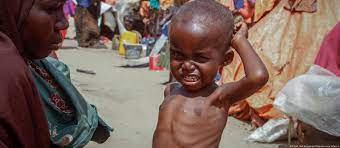Definition
Protein-energy malnutrition (PEM) in children refers to a deficiency of essential nutrients, including carbohydrates, protein, and fat, which are required in significant amounts for proper energy supply. This disease frequently coexists with deficits in micronutrients.
Causes
PEM can be categorized as mild, moderate, or severe. International standards calculate staging to calculate body weight based on height or body length.
Based on the underlying causal mechanism, PEM can be classified as either primary (resulting from inadequate nutritional consumption) or secondary (attributable to diseases or medications impairing the body's use of nutrients).
PEM predominantly affects infants and the elderly, who lack access to nutrition on a global scale. Additionally, fasting and anorexia nervosa (an eating disorder) can induce PEM. Child violence may also constitute a contributing factor.
Chronic (long-term) primary PEM in children manifests in two distinct forms:
- Marasmus
This condition is characterized by muscle and adipose loss and weight loss. In nations where food sources are unstable, marasmus is the most prevalent manifestation of PEM in children.
- Kwashiorkor
This disorder, commonly known as lactation insufficiency, is frequently attributed to the cessation of breastfeeding when a mother gives birth to her second or subsequent child, resulting in older children being deprived of breast milk. Kwashiorkor can also arise after an acute illness, such as a gastrointestinal infection or other infection, in a kid with moderate protein-energy malnutrition (PEM).
Kwashiorkor is more likely to occur in diets with a lower protein-to-calorie ratio than marasmus. Kwashiorkor is less prevalent than marasmus and exhibits a higher incidence in specific regions, including Africa, the Caribbean, and the Pacific Islands. In this region, basic foods, such as sweet potatoes and potatoes, have a low protein content and high levels of carbohydrates.
Secondary PEM primarily arises from:
- Gastrointestinal disorders that impair the functionality of the digestive system, consequently interfering with the absorption of nutrients
- Chronic disorders, such as AIDS, cancer, COPD, heart failure, and renal failure, lead to heightened degradation of nutrients
- Factors that elevate metabolic requirements include infections, hyperthyroidism, pheochromocytoma, endocrine disorders, burns, traumas, surgical procedures, and other severe medical conditions
The initial physiological reaction to PEM is a reduction in metabolic rate. For energy provision, the body will initially metabolize adipose tissue. After reducing adipose tissue, the body will convert protein into an energy substrate. Internal organs and musculature will also be degraded, leading to weight loss.
Risk Factor
In nations with adequate food resources, malnutrition-related energy deficiency (PEM) is more prevalent among the elderly and individuals with conditions that result in reduced appetite or impaired digestion, absorption, and metabolism of nutrients. However, in nations with unreliable food supplies, malnutrition-related edema (PEM) is more prevalent among children who suffer from insufficient caloric and protein intake.
Symptoms
PEM might manifest suddenly, entirely, or gradually. Edema, alopecia, and dermal thinning may also be present, and the severity of the condition can range from asymptomatic to extreme emaciation. Individuals with PEM may encounter diminished cognitive abilities and exhibit heightened restlessness or even indifference. PEM can cause menstrual cycle issues in adolescent girls.
The manifest symptoms will correspond to the compromised functionality of the organ systems within the body. Based on the conditions encountered, the following are frequent symptoms:
- Marasmus in infants results in malnutrition, muscle and tissue depletion, and weight loss. Facial and rib cage features are prominent. The epidermis appears slack and delicate, with protruding folds visible
- Kwashiorkor is characterized by edema in the extremities and ocular region due to hypoalbuminemia. Abdominal muscular weakness, intestinal swelling, liver enlargement, and fluid accumulation in the abdominal cavity will cause the stomach to protrude. Dehydrated, slender, and creased skin. Hair can undergo thinning, acquire a reddish-brown hue, or become gray. Excessive hair loss can result in a visibly thin and sparse appearance. Nevertheless, eyelashes have the potential to grow excessively
Diagnosis
PEM is generally diagnosed based on a child's significantly inadequate dietary intake history. In a physical examination, anatomical features such as body fat distribution, muscle mass, height, and weight may be assessed. Body mass index (BMI), blood transferrin, lymphocyte (white blood cell) count, and blood albumin levels can all be evaluated to ascertain the degree of severity.
Complete blood tests, electrolytes, glucose, calcium, magnesium, phosphate, and blood urea nitrogen are required in the absence of a history of inadequate food consumption.
To find out what causes secondary PEM, more laboratory tests are needed. For example, thyroid function and signs of inflammation (like C-reactive protein) must be checked.
If a child experiences severe diarrhea or fails to respond to therapy, a stool examination might be conducted to detect the presence of eggs or parasites. Urine analysis, blood culture, tuberculosis screening, and chest X-rays are employed to detect latent infections due to the compromised immune response observed in children with PEM.
Management
Mild or moderate PEM can be managed with oral intake from a well-balanced diet. On the other hand, when MEP is severe, it necessitates inpatient therapy along with a regulated diet. The primary focus is to rectify any imbalances in bodily fluids and electrolytes and address any infections. Antibiotics may be prescribed as a preventive measure against infection.
The next priority is to supply the necessary nutrients in large quantities by oral intake or, if necessary (for example, if there is difficulty swallowing), through a feeding or nasogastric tube. Intravenous nutrition is given if there are severe absorption disorders.
Furthermore, treatment of the underlying disease or condition is also necessary in cases of secondary PEM.
Complications
Marasmus and Kwashiorkor result in immune system disorders, heightening the child's susceptibility to infections. Frequently, bacterial infections, including lung infections, gastrointestinal infections, ear infections, urinary tract infections, and other severe illnesses, manifest. These infections can trigger the production of inflammatory chemicals, leading to decreased appetite, exacerbated muscle wasting, and a substantial decline in blood albumin levels.
In addition, MEP can induce liver, renal, and cardiac failure.
PEM therapy may lead to problems such as refeeding syndrome, characterized by fluid overload, electrolyte imbalances, hyperglycemia, cardiac arrhythmias, and diarrhea. Diarrhea is typically moderate, but in severe cases of MEP, it can lead to significant dehydration or even mortality.
Prevention
Breastfeeding for a minimum of 6 months is the most effective method to avoid malnutrition throughout the early stages of life. Before implementing a specialized diet, such as vegetarian or low-carbohydrate, for a child, it is advisable to get guidance from a medical professional to ensure that the child receives the necessary nutritional requirements.
When to see a doctor?
If your child is experiencing weight loss, persistent diarrhea, or displaying other symptoms of PEM, it is advisable to get medical advice from a doctor.
If you need medical advice or consultation, you can either visit a doctor or use the consultation features available in the Ai Care application by downloading the Ai Care application from the App Store or Play Store.
If you need medical advice or consultation, you can either visit a doctor or use the consultation features available in the Ai Care application by downloading the Ai Care application from the App Store or Play Store.
Looking for more information about other diseases? Click here!
- dr. Lukita Tarigan
Morley, J. E. (2023, February 14). Protein-energy undernutrition (PEU) is a nutritional disorder. MSD Manual Professional Edition. Retrieved January 19, 2023, from https://www.msdmanuals.com/professional/nutritional-disorders/undernutrition/protein-energy-undernutrition-peu
Protein-energy malnutrition. DermNet. (n.d.). Retrieved January 19, 2023, from https://dermnetnz.org/topics/protein-energy-malnutrition
Protein-energy malnutrition. Encyclopedia of Children's Health. (n.d.). Retrieved January 19, 2023, from http://www.healthofchildren.com/P/Protein-Energy-Malnutrition.html











